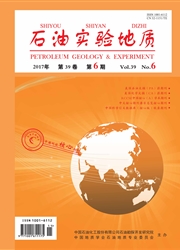

 中文摘要:
中文摘要:
全球已开发千余个目的层系埋深超过4500 m的油气田,深层油气勘探的重要性日益突出,而准噶尔盆地已开发目的层系埋深均浅于4500 m,尚未在深层取得突破。因此,有必要开展准噶尔盆地深层油气藏形成条件的研究。在总结前人研究成果的基础上,总结了深层烃源岩、储集层和盖层的发育情况以及油气的保存条件,并进行了系统分析。研究认为,盆地中央坳陷和南缘深层广泛发育多套泥质烃源岩且已处于成熟—高成熟阶段,生排烃潜力大;由于溶蚀和超压等地质作用,盆地深层普遍发育相对优质的储集层段,出现“差中有优”的现象;湖盆扩张期形成的多套区域盖层能够起到较好的封盖效果,有利于深层油气的聚集与保存。根据生储盖在时间和空间上的匹配关系,以及探井深层油气显示情况,表明中央坳陷和南缘为深层油气有利勘探区。
 英文摘要:
英文摘要:
With the increasing degree of identified shallow hydrocarbon resources, the possibility of making a breakthrough in shallow strata is decreasing and the direction of oil and gas exploration is turning to deep strata. All around the world, over one thousand hydrocarbon reservoirs have been discovered and developed in deep strata with buried depth greater than 4 500 m. At present, the depth of all the discovered and developed hydrocarbon reservoirs is less than 4 500 m in the Junggar Basin. Considering that a breakthrough has not yet been made in deep strata, a discussion of deep hydrocarbon accumulation conditions has important practical significance in the Junggar Basin. Based on previous studies, source rocks, reservoirs, cap rocks and preservation conditions are taken as research subjects and the accumulation conditions of deep hydrocarbon are analyzed. The southern margin and central depression of the basin developed many sets of argillaceous source rocks in the deep zone and have entered into the mature to highmaturity stage. Due to the geological processes of overpressure and erosion, etc., relatively highquality reservoir intervals are widely developed in deep strata. Many regional cap rocks can be effective seals, beneficial to deep oil and gas accumulation and preservation. Timing and spatial relationships among source rocks, reservoirs, cap rocks, and the hydrocarbon shows in deep strata of exploration wells suggest that the central depression and southern margin are favorable zones for deep oil and gas exploration.
 同期刊论文项目
同期刊论文项目
 同项目期刊论文
同项目期刊论文
 期刊信息
期刊信息
